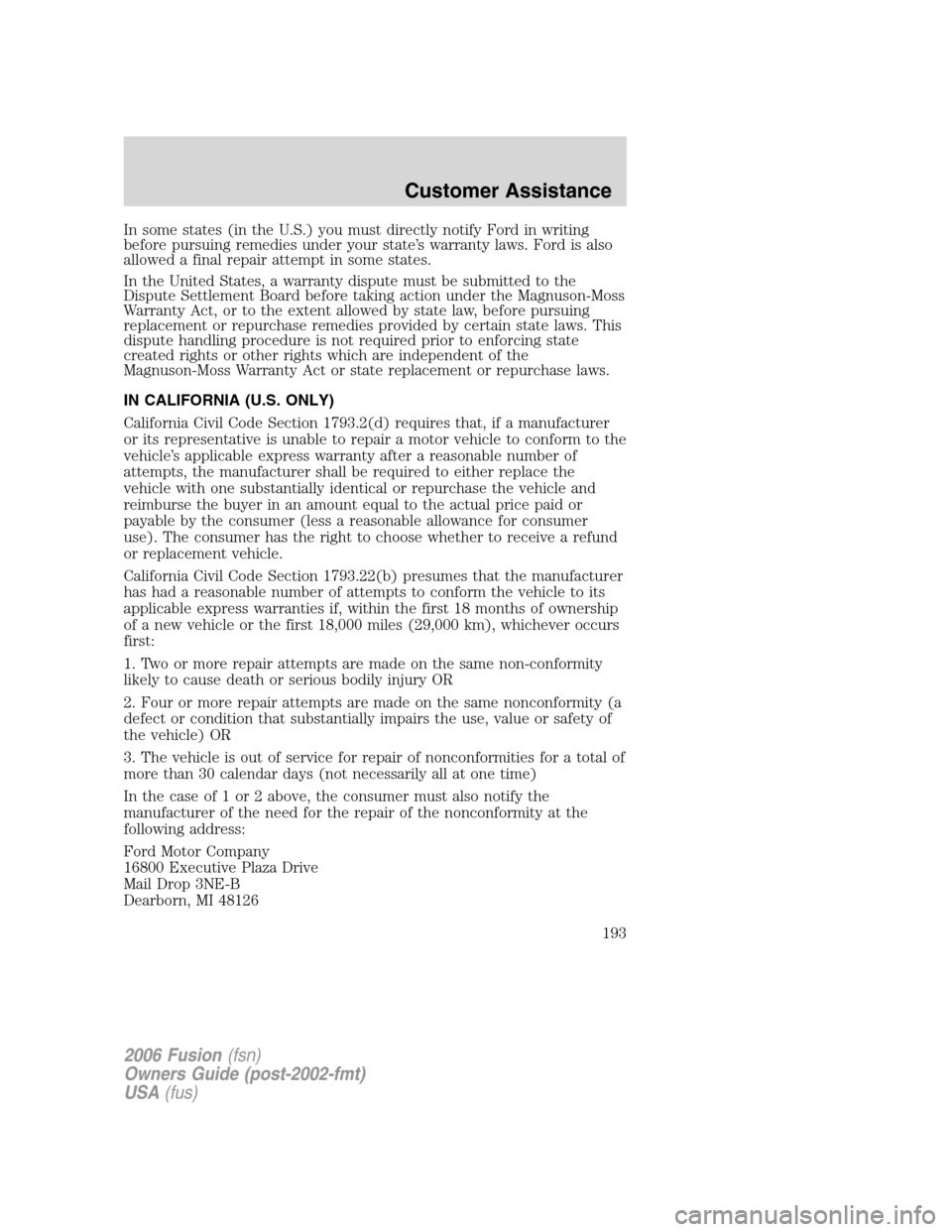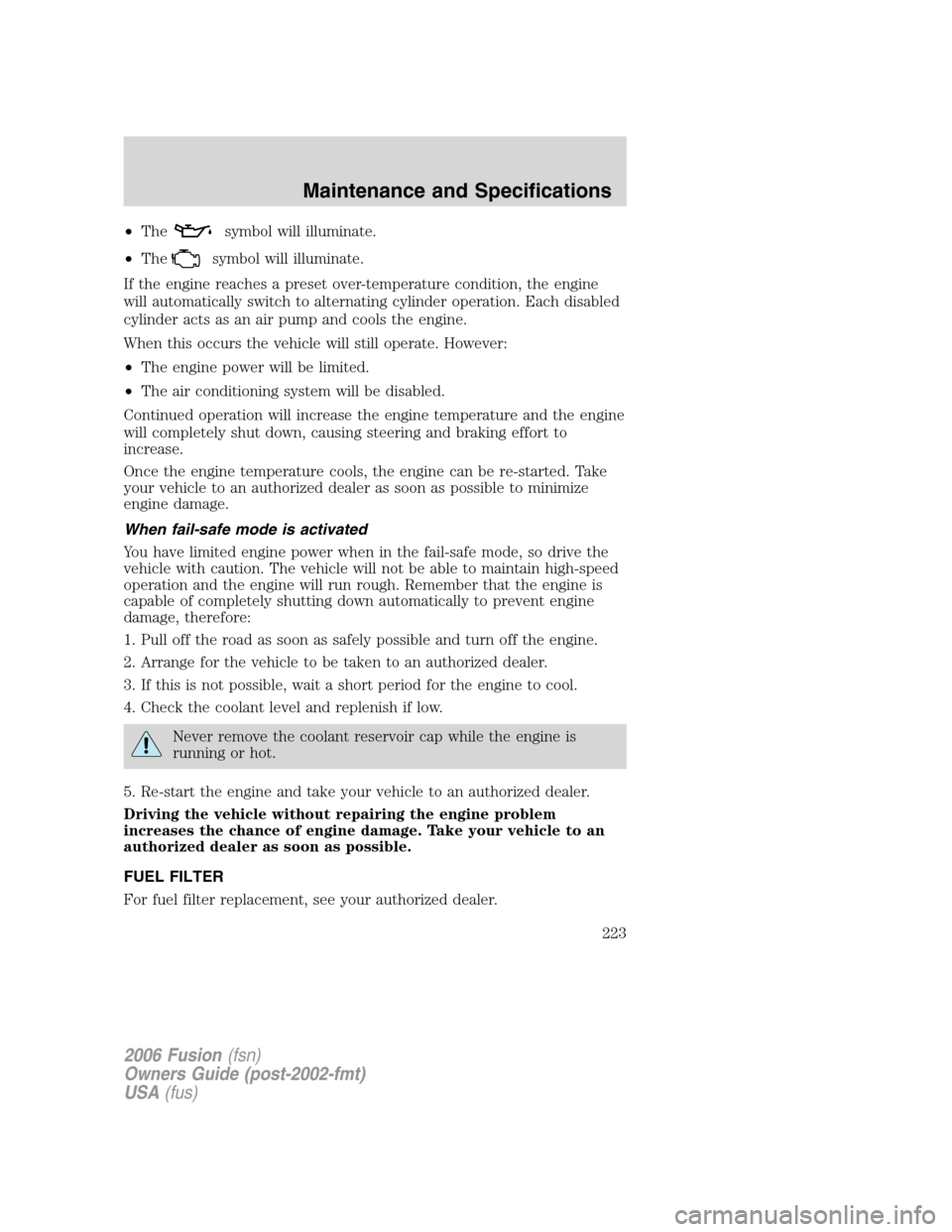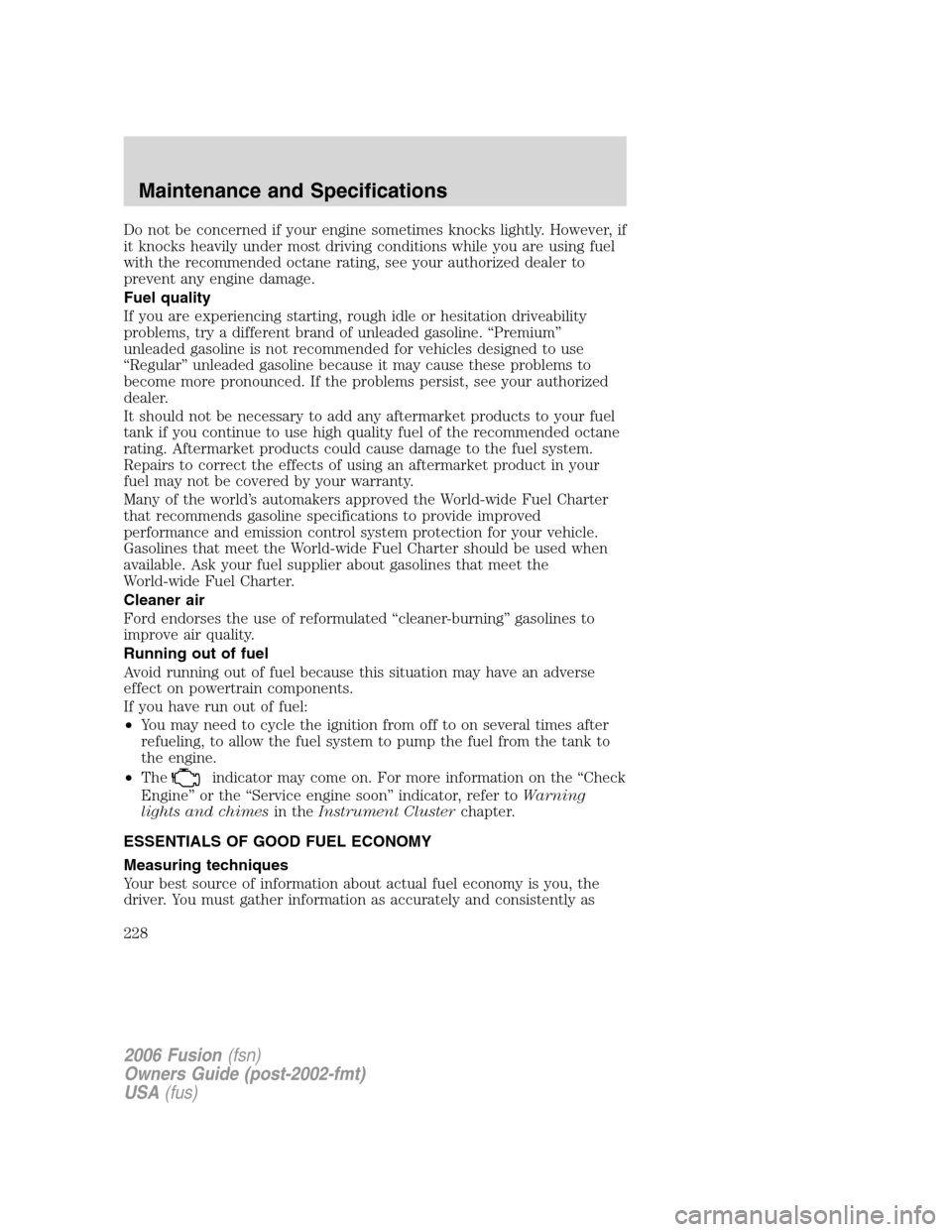2006 FORD FUSION (AMERICAS) air condition
[x] Cancel search: air conditionPage 136 of 264

The traction grade assigned to this tire is based on
straight-ahead braking traction tests, and does not include
acceleration, cornering, hydroplaning or peak traction characteristics.
Temperature A B C
The temperature grades are A (the highest), B and C, representing the
tire’s resistance to the generation of heat and its ability to dissipate heat
when tested under controlled conditions on a specified indoor laboratory
test wheel. Sustained high temperature can cause the material of the tire
to degenerate and reduce tire life, and excessive temperature can lead to
sudden tire failure. The grade C corresponds to a level of performance
which all passenger car tires must meet under the Federal Motor Vehicle
Safety Standard No. 109. Grades B and A represent higher levels of
performance on the laboratory test wheel than the minimum required by
law.
The temperature grade for this tire is established for a tire that
is properly inflated and not overloaded. Excessive speed,
underinflation, or excessive loading, either separately or in
combination, can cause heat buildup and possible tire failure.
TIRES
Tires are designed to give many thousands of miles of service, but they
must be maintained in order to get the maximum benefit from them.
Glossary of tire terminology
•Tire label:A label showing the OE (Original Equipment) tire sizes,
recommended inflation pressure and the maximum weight the vehicle
can carry.
•Tire Identification Number (TIN):A number on the sidewall of
each tire providing information about the tire brand and
manufacturing plant, tire size and date of manufacture. Also referred
to as DOT code.
•Inflation pressure:A measure of the amount of air in a tire.
•Standard load:A class of P-metric or Metric tires designed to carry a
maximum load at 35 psi [37 psi (2.5 bar) for Metric tires]. Increasing
the inflation pressure beyond this pressure will not increase the tire’s
load carrying capability.
•Extra load:A class of P-metric or Metric tires designed to carry a
heavier maximum load at 41 psi [43 psi (2.9 bar) for Metric tires].
2006 Fusion(fsn)
Owners Guide (post-2002-fmt)
USA(fus)
Tires, Wheels and Loading
136
Page 159 of 264

Starting the engine
1. Turn the key to 3 (RUN) without
turning the key to 4 (START).
2. Turn the key to 4 (START), then
release the key as soon as the
engine starts. Excessive cranking
could damage the starter.
Note:If the engine does not start within five seconds on the first try,
turn the key to LOCK, wait 10 seconds and try again. If the engine still
fails to start, press the accelerator to the floor and try again; this will
allow the engine to crank with the fuel shut off in case the engine is
flooded with fuel.
Guarding against exhaust fumes
Carbon monoxide is present in exhaust fumes. Take precautions to avoid
its dangerous effects.
If you smell exhaust fumes inside your vehicle, have your dealer
inspect your vehicle immediately. Do not drive if you smell
exhaust fumes.
Important ventilating information
If the engine is idling while the vehicle is stopped for a long period of
time, open the windows at least one inch (2.5 cm) or adjust the heating
or air conditioning to bring in fresh air.
USING THE ENGINE BLOCK HEATER (IF EQUIPPED)
An engine block heater warms the engine coolant which aids in starting
and heater/defroster performance. Use of an engine block heater is
strongly recommended if you live in a region where temperatures reach
-10°F (-23°C) or below. For best results, plug the heater in at least three
hours before starting the vehicle. The heater can be plugged in the night
before starting the vehicle.
To reduce the risk of electrical shock, do not use your heater
with ungrounded electrical systems or two-pronged (cheater)
adapters.
2006 Fusion(fsn)
Owners Guide (post-2002-fmt)
USA(fus)
Driving
159
Page 193 of 264

In some states (in the U.S.) you must directly notify Ford in writing
before pursuing remedies under your state’s warranty laws. Ford is also
allowed a final repair attempt in some states.
In the United States, a warranty dispute must be submitted to the
Dispute Settlement Board before taking action under the Magnuson-Moss
Warranty Act, or to the extent allowed by state law, before pursuing
replacement or repurchase remedies provided by certain state laws. This
dispute handling procedure is not required prior to enforcing state
created rights or other rights which are independent of the
Magnuson-Moss Warranty Act or state replacement or repurchase laws.
IN CALIFORNIA (U.S. ONLY)
California Civil Code Section 1793.2(d) requires that, if a manufacturer
or its representative is unable to repair a motor vehicle to conform to the
vehicle’s applicable express warranty after a reasonable number of
attempts, the manufacturer shall be required to either replace the
vehicle with one substantially identical or repurchase the vehicle and
reimburse the buyer in an amount equal to the actual price paid or
payable by the consumer (less a reasonable allowance for consumer
use). The consumer has the right to choose whether to receive a refund
or replacement vehicle.
California Civil Code Section 1793.22(b) presumes that the manufacturer
has had a reasonable number of attempts to conform the vehicle to its
applicable express warranties if, within the first 18 months of ownership
of a new vehicle or the first 18,000 miles (29,000 km), whichever occurs
first:
1. Two or more repair attempts are made on the same non-conformity
likely to cause death or serious bodily injury OR
2. Four or more repair attempts are made on the same nonconformity (a
defect or condition that substantially impairs the use, value or safety of
the vehicle) OR
3. The vehicle is out of service for repair of nonconformities for a total of
more than 30 calendar days (not necessarily all at one time)
In the case of 1 or 2 above, the consumer must also notify the
manufacturer of the need for the repair of the nonconformity at the
following address:
Ford Motor Company
16800 Executive Plaza Drive
Mail Drop 3NE-B
Dearborn, MI 48126
2006 Fusion(fsn)
Owners Guide (post-2002-fmt)
USA(fus)
Customer Assistance
193
Page 223 of 264

•Thesymbol will illuminate.
•The
symbol will illuminate.
If the engine reaches a preset over-temperature condition, the engine
will automatically switch to alternating cylinder operation. Each disabled
cylinder acts as an air pump and cools the engine.
When this occurs the vehicle will still operate. However:
•The engine power will be limited.
•The air conditioning system will be disabled.
Continued operation will increase the engine temperature and the engine
will completely shut down, causing steering and braking effort to
increase.
Once the engine temperature cools, the engine can be re-started. Take
your vehicle to an authorized dealer as soon as possible to minimize
engine damage.
When fail-safe mode is activated
You have limited engine power when in the fail-safe mode, so drive the
vehicle with caution. The vehicle will not be able to maintain high-speed
operation and the engine will run rough. Remember that the engine is
capable of completely shutting down automatically to prevent engine
damage, therefore:
1. Pull off the road as soon as safely possible and turn off the engine.
2. Arrange for the vehicle to be taken to an authorized dealer.
3. If this is not possible, wait a short period for the engine to cool.
4. Check the coolant level and replenish if low.
Never remove the coolant reservoir cap while the engine is
running or hot.
5. Re-start the engine and take your vehicle to an authorized dealer.
Driving the vehicle without repairing the engine problem
increases the chance of engine damage. Take your vehicle to an
authorized dealer as soon as possible.
FUEL FILTER
For fuel filter replacement, see your authorized dealer.
2006 Fusion(fsn)
Owners Guide (post-2002-fmt)
USA(fus)
Maintenance and Specifications
223
Page 228 of 264

Do not be concerned if your engine sometimes knocks lightly. However, if
it knocks heavily under most driving conditions while you are using fuel
with the recommended octane rating, see your authorized dealer to
prevent any engine damage.
Fuel quality
If you are experiencing starting, rough idle or hesitation driveability
problems, try a different brand of unleaded gasoline. “Premium”
unleaded gasoline is not recommended for vehicles designed to use
“Regular” unleaded gasoline because it may cause these problems to
become more pronounced. If the problems persist, see your authorized
dealer.
It should not be necessary to add any aftermarket products to your fuel
tank if you continue to use high quality fuel of the recommended octane
rating. Aftermarket products could cause damage to the fuel system.
Repairs to correct the effects of using an aftermarket product in your
fuel may not be covered by your warranty.
Many of the world’s automakers approved the World-wide Fuel Charter
that recommends gasoline specifications to provide improved
performance and emission control system protection for your vehicle.
Gasolines that meet the World-wide Fuel Charter should be used when
available. Ask your fuel supplier about gasolines that meet the
World-wide Fuel Charter.
Cleaner air
Ford endorses the use of reformulated “cleaner-burning” gasolines to
improve air quality.
Running out of fuel
Avoid running out of fuel because this situation may have an adverse
effect on powertrain components.
If you have run out of fuel:
•You may need to cycle the ignition from off to on several times after
refueling, to allow the fuel system to pump the fuel from the tank to
the engine.
•The
indicator may come on. For more information on the “Check
Engine” or the “Service engine soon” indicator, refer toWarning
lights and chimesin theInstrument Clusterchapter.
ESSENTIALS OF GOOD FUEL ECONOMY
Measuring techniques
Your best source of information about actual fuel economy is you, the
driver. You must gather information as accurately and consistently as
2006 Fusion(fsn)
Owners Guide (post-2002-fmt)
USA(fus)
Maintenance and Specifications
228
Page 230 of 264

3. After at least three to five tank fill-ups, fill the fuel tank and record
the current odometer reading.
4. Subtract your initial odometer reading from the current odometer
reading.
5. Follow one of the simple calculations in order to determine fuel
economy:
Calculation 1:Divide total miles traveled by total gallons used.
Calculation 2:Multiply liters used by 100, then divide by total
kilometers traveled.
Keep a record for at least one month and record the type of driving (city
or highway). This will provide an accurate estimate of the vehicle’s fuel
economy under current driving conditions. Additionally, keeping records
during summer and winter will show how temperature impacts fuel
economy. In general, lower temperatures give lower fuel economy.
Driving style — good driving and fuel economy habits
Give consideration to the lists that follow and you may be able to change
a number of variables and improve your fuel economy.
Habits
•Smooth, moderate operation can yield up to 10% savings in fuel.
•Steady speeds without stopping will usually give the best fuel
economy.
•Idling for long periods of time (greater than one minute) may waste
fuel.
•Anticipate stopping; slowing down may eliminate the need to stop.
•Sudden or hard accelerations may reduce fuel economy.
•Slow down gradually.
•Driving at reasonable speeds (traveling at 55 mph [88 km/h] uses
15% less fuel than traveling at 65 mph [105 km/h]).
•Revving the engine before turning it off may reduce fuel economy.
•Using the air conditioner or defroster may reduce fuel economy.
•You may want to turn off the speed control in hilly terrain if
unnecessary shifting between third and fourth gear occurs.
Unnecessary shifting of this type could result in reduced fuel
economy.
•Warming up a vehicle on cold mornings is not required and may
reduce fuel economy.
2006 Fusion(fsn)
Owners Guide (post-2002-fmt)
USA(fus)
Maintenance and Specifications
230
Page 254 of 264

A
Accessory delay ..........................53
Air cleaner filter ...............240–242
Air conditioning ....................29, 31
Airbag supplemental restraint
system ................107–108, 116, 119
and child safety seats ............109
description ..............108, 116, 119
disposal ....................................123
driver airbag ............110, 117, 121
indicator light .........116, 118, 122
operation .................110, 117, 121
passenger airbag .....110, 117, 121
side airbag .......................116, 119
Antifreeze
(see Engine coolant) ................218
Anti-lock brake system
(see Brakes) ......................160–161
Anti-theft system ........................85
arming the system ....................85
disarming a triggered system ..86
Audio system (see Radio) ...17, 21
Automatic transaxle
fluid, adding ....................235, 237
fluid, checking ................235, 237
Automatic transmission
driving an automatic
overdrive .........................165–166
fluid, refill capacities ..............243
fluid, specification ..................246
Axle
lubricant specifications ..245–246
B
Battery .......................................216
acid, treating emergencies .....216
jumping a disabled battery ....185maintenance-free ....................216
replacement, specifications ...242
servicing ..................................216
BeltMinder .................................102
Brakes ........................................160
anti-lock ...........................160–161
anti-lock brake system
(ABS) warning light ...............160
fluid, checking and adding ....235
fluid, refill capacities ..............243
fluid, specifications .........245–246
lubricant specifications ..245–246
parking ....................................161
shift interlock ..........................163
Break-in period .............................5
Bulbs ............................................39
C
Capacities for refilling fluids ....243
Cassette tape player ...................17
Cell phone use ..............................7
Changing a tire .........................179
Child safety restraints ..............123
child safety belts ....................123
Child safety seats ......................127
attaching with tether straps ..131
in front seat ............................128
in rear seat ..............................128
Cleaning your vehicle
engine compartment ..............199
instrument panel ....................202
interior .....................................203
interior trim ............................203
plastic parts ............................201
washing ....................................198
waxing .....................................198
wheels ......................................199
wiper blades ............................202
2006 Fusion(fsn)
Owners Guide (post-2002-fmt)
USA(fus)
Index
254
Page 255 of 264

Climate control (see Air
conditioning or Heating) ......29, 31
Clock ............................................51
Clock adjust
6-CD in dash .............................22
AM/FM/CD .................................17
Clutch
fluid ..........................................235
operation while driving ..........168
recommended shift speeds
....168
Compass, electronic
set zone adjustment
.................63
Console
........................................51
overhead
..............................50–51
Controls
power seat
.................................90
steering column
........................58
Coolant
checking and adding
..............218
refill capacities
................221, 243
specifications
..................245–246
Cruise control
(see Speed control)
....................55
Cupholder(s)
...............................93
Customer Assistance
................170
Ford Extended Service Plan
.195
Getting assistance outside
the U.S. and Canada
..............196
Getting roadside assistance
...170
Getting the service
you need
.................................191
Ordering additional owner’s
literature
.................................196
Utilizing the Mediation/
Arbitration Program
...............194D
Daytime running lamps
(see Lamps) ................................36
Dipstick
automatic transmission
fluid ..................................235, 237
engine oil .................................211
Doors
lubricant specifications ..........245
Driving under special
conditions ..................................167
through water .........................169
E
Electronic message center .........61
Emergencies, roadside
jump-starting ..........................185
Emission control system ..........232
Engine ................................246–247
cleaning ...................................199
coolant .....................................218
fail-safe cooling .......................222
idle speed control ...................216
lubrication
specifications ..................245–246
refill capacities ........................243
service points ..................208–209
starting after a collision .........172
Engine block heater .................159
Engine oil ..................................211
change oil soon warning,
message center .......................211
checking and adding ..............211
dipstick ....................................211
filter, specifications ........215, 242
recommendations ...................215
refill capacities ........................243
specifications ..................245–246
Exhaust fumes ..........................159
2006 Fusion(fsn)
Owners Guide (post-2002-fmt)
USA(fus)
Index
255